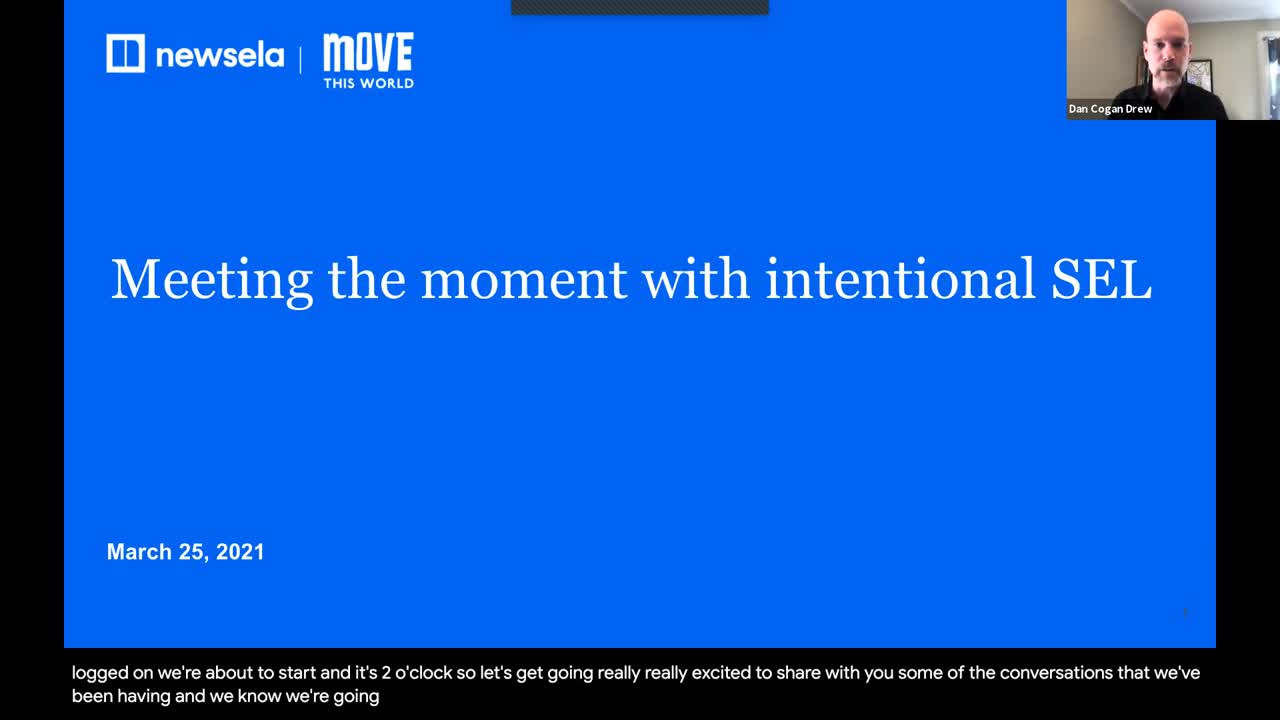Webinar Recap: Meeting the Moment With Intentional SEL
Anyone who works with students knows that they are innately curious, in even the most difficult circumstances. However, we also know that there are many factors that may prevent students from translating that intrinsic motivation into a capacity to learn academic content. The past year of remote learning has demonstrated beyond a doubt that intentional social-emotional learning (SEL) is one powerful tool to remove those obstacles.
With funding decisions imminent, the pressure to address pandemic-related learning loss may force educators to prioritize academic remediation at the expense of SEL and whole-child pedagogies. But there’s also growing awareness that the pandemic has harmed students in ways that go beyond academic learning loss. Supporting sustainable academic and emotional growth requires a different approach: intentional SEL.
Speakers:
- Sara LaHayne, Founder and CEO, Move This World
- Mathew Portell, Principal, Fall-Hamilton Elementary
- Mary Crnobori, District Coordinator of Trauma-Informed Schools, Metro Nashville Public Schools
- Dan Cogan-Drew, Co-Founder and Chief Academic Officer, Newsela

Prioritizing SEL over drill-and-kill
Fully addressing the learning loss that has happened during the pandemic will take years, so it makes sense that schools concerned about their students’ achievement (and their funding) would embrace pedagogies that promise fast learning recovery. However, these strategies often fall into the category of “drill-and-kill” tactics — and they are deeply unsustainable. To preserve students’ innate love of learning, districts must support their educators in prioritizing SEL.
Mathew Portell, Principal at Fall-Hamilton Elementary in Nashville, Tennessee, shared the positive outcomes that came when he abandoned his assumptions about what he should be doing as a principal, and instead implemented SEL practices. In his first year as principal, he suspended 32 students for 56 days, received 220 disciplinary referrals for a school with only 320 students, and grappled with a staff retention rate of only 50%. Portell shared that when he learned about new SEL approaches, “I realized if I continue to do what I was doing, I was committing malpractice towards our kids.”
This could not continue, so he initiated a culture overhaul that focused on social and emotional support rather than punishment and exclusion, “wrap[ping] our kids around with services to help in these situations [that lead to disciplinary issues].” Six years later, the staff have returned and they have a 93% satisfaction rate, and Fall-Hamilton has “completely eliminated suspensions and exclusionary practices.”
Finding a home for SEL in core instruction
With limited instructional time and many students still learning remotely, some educators may feel they have to choose between academics and SEL. However, the panelists agreed that SEL and core academic content are not only highly compatible, but dependent upon each other. As Portell put it, “When we’re talking about the integration of social and emotional learning … with academics, there is no integration, because they’re the same. We are social and emotional beings, and therefore, we learn socially and emotionally.”
That starts with choosing instructional materials that support SEL goals. Dan Cogan-Drew explained that by choosing texts in which all learners can see themselves and feel positively affirmed, educators can support a universal sense of belonging, as well as self-efficacy, value, and control. These are inherently valuable features of any educational environment, and just as critically, they are foundations for learning. People learn best when they feel a sense of agency, ability, and connection to their community… and representational literacy texts are a powerful way to develop this.
Opportunities for SEL connections span beyond literacy texts. Sara Potler LaHayne shared the powerful example of teaching the science behind emotions—a topic that connects to core science content about the brain, while also giving students the tools to think about their emotions in a more empowered way. When they understand the neurology that drives their feelings, LaHayne explained, students are able to “hold one another and their parents and grownups accountable for how they manage their emotions.”
Dr. Mary Crnobori added that adult accountability is critical: To maximize SEL’s potential for collective impact, educators must share their students’ understanding and language about emotions and the brain. This may involve a major paradigm shift in a field that has not always prioritized SEL-centered policies and norms. However, when teachers are able to enact the same mindfulness and self-regulation practices as their students, they can achieve breakthroughs in how they relate to even the learners with the most severe behavioral challenges.
A great SEL program needs a clear scope and sequence
The best SEL is sequenced and has a clear scope. LaHayne explained that an effective SEL program should be: 1) developmentally appropriate; 2) enacted, as opposed to consuming texts or filling out worksheets; 3) focused; and 4) explicit. Having a defined scope and sequence makes it easier for educators to scaffold: Rather than starting by asking students to share personal struggles in a way they are not prepared for, they can instead begin with topics like breath work and tension in the body. In this way, teachers can build a safe community where everyone can be vulnerable and grow together.
As LaHayne put it, great SEL “is not just [SEL] by osmosis. It really does need to be intentional with an evidence-based curriculum” — just like any academic subject area.
Add SEL to daily instruction
With the Newsela SEL collection, it's easy to be intentional about adding social-emotional learning moment to core subjects and materials. Discover how incorporate relatable, accessible activities into classroom instruction that put students in the right mindset to learn.